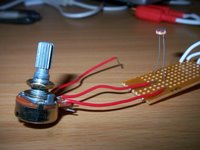
You can listen to one result here (mp3, 350kb). This example uses a 220Hz sinewave as a carrier and the fan slowing down (from a high speed to off) as a modulator. It is a completely dry recording ie. no room sounds (and no physical/mechanical fan sounds) are present.
If you look at the protools screen capture below, you can very clearly see the change in speed of the amplitude modulation as the fan slows down. The image is the last 13 seconds or so of the mp3 example (link is above). This also gives a visual indication of how deep the modulation is. I want to replace the 100KΩ pot with a 1MΩ pot and see if the modulation can go deeper than demonstrated with the full 100KΩ in effect. I've got some other plans for this thing as well...




6 comments:
Aha! Makeover!! Someone's upgraded to the new version of Blogger. I think I understand why you may need to borrow a fan as well.
;-) yep. i quite like the new version of blogger. it's got some neat features!
Hello! That's sounds interesting. Do you have a schema of the circuit?
Hi there Micheline,
Thanks for your comment...
This "circuit" is simply a voltage divider. One side is the 100KΩ (or higher) pot, on the other side is the light dependent resistor (LDR). So...
- Audio input signal connects to leg 1 or 3 of the pot
- Audio input ground connects to leg 2 of the LDR
- Audio output signal connects to leg 2 of the pot as well as leg 1 of the LDR
in >------- (terminal
|
| 100KΩ + pot
|
out <----- (wiper)
|
| LDR
|
gnd -------
Or something like this. ;-)
Overly basic!!!
Oh! Thank you! Rou are right, it seems easy your right. Continue your experiemnts...! m
Yep, dead easy. Shouldn't take more than a couple of minutes. That's the good part about it. Try using a pot that is greater than 100KΩ... I only used it because I had one spare... ;-)
Let me know if you decide to make this one or whatev.
Post a Comment